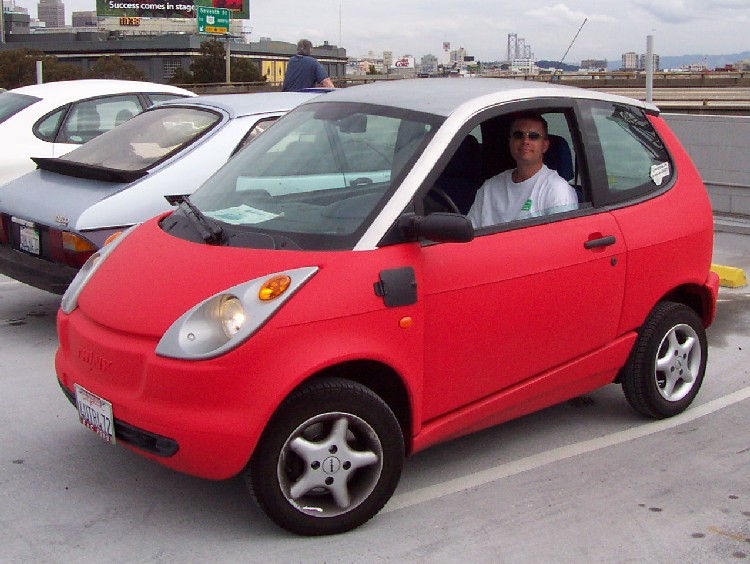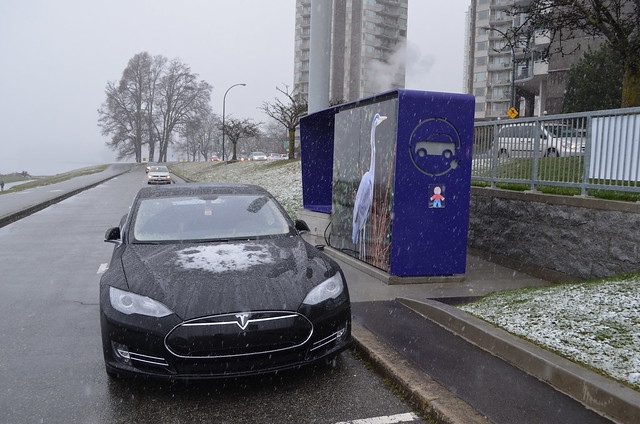See, in the field of automotive journalism, entire careers are made by picking out the soft targets and thrashing them mercilessly. These public pistol-whippings are meant to lend credibility to the reviewer, so readers will overlook the fact that 99% of their other articles are simple industry puff pieces. Funny how the Nissan Leaf gets such hate, while a miserable turd like the 2007 Chevy Aveo has an "eye-catching shell" and a "pleasant nimbleness." I guess you don't bite the hand that feeds you.
It makes sense that most portrayals of the electric car are negative in media, automotive or otherwise. Manufacturers don't like making the cars. They're different than conventional cars in very tangible ways, and they don't sell well. Many EV startups go bankrupt. Until recently, the electric car was no more than a glorified golf cart. Someone looking for a soft target to trash wouldn't have to think twice about ripping into a Th!nk EV.
 |
| dignity not included. |
So, like nobody has ever really said, if you can't beat 'em, join 'em.
5 Reasons the Combustion Engine isn't ready for Neon Deion.
5) They're stinky, dirty, and loud.
After driving the Leaf for a while, borrowing a gas-powered car is almost sensory overload. VROOOOOOOM! The exhaust smells absolutely awful and leaves a fine soot, REEEEEEEEE!!!! and you're surprised how you didn't notice the smell until you didn't have to deal with it for 6 months. BWAAAAAH! Don't get me started on changing oil. Oh, and there's the noisy chorus of the drivetrain. Electric drive is silent, clean, and free of fumes.4) They're prohibitively expensive to operate.
Maintenance adds up quickly. Gas adds up even quicker. Imagine filling up your gas tank for 6 bucks - That's how much it costs to drive the same distance in an electric car. The difference can add up to a car payment each month. To put it another way, the cost of driving the average family sedan is $9000 this year, by AAA's numbers. The Leaf is less than half that.3) They lead to Funyun breath.
Sure, you can drive 300 miles, refuel, and drive 300 more. But refueling sucks - you get gas-hands, stand outside while inhaling the fumes of the other cars idling around you, and get suckered into buying things you don't need, like Funyuns and lotto tickets. With an electric car, it's much easier to drive home, turn off your car, and plug it in. It takes a total of maybe 10 seconds, and no Funyuns.2) They encourage poor driving habits.
When you've got fossil fuel to spare in the tank, there's no real impetus to drive sanely. Instead, drivers speed, doing 80 mph on the freeway, and accelerate from red light to red light in the city. You end up driving like a madman, burning rubber just to slam on the brakes 90 feet ahead. The driver of an electric car watches range available like a hawk, and adopts efficient driving habits almost subconsciously. When you have an EV available, you also choose the most responsible mode of transportation available for short trips, and leave the gas-burner for longer trips.1) They make you sick.
Okay, electricity comes largely from coal, which is itself a dirty fuel, but most people don't live in the same proximity to coal plants that they do to a million car tailpipes. Infernal-combustion engines emit many toxins right in our faces. There are Nitrogen Oxides, which can substantially worsen lung conditions like COPD and asthma. The exhaust helps form the major ingredients in smog. Exposure to the benzenes and particulate matter in exhaust has been shown to cause cancer over time.But hey, at least they can go 300 miles on a tank, right?













